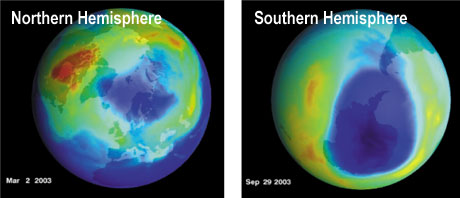The Aura Satellite, launched from Vandenberg Air Force Base on July 15, 2004, is a NASA mission to collect information to help answer these questions.
Greenhouse Gases and Climate Change
Aura will measure greenhouse gases in the Earth’s atmosphere, increasing our understanding of the causes and consequences of global climate change. For more on climate change, see this page.
Ozone
Measurements taken on Aura will also help determine whether the stratospheric ozone layer is recovering from damage and “holes” created due to reactions involving chemicals released on Earth known as chlorofluorocarbons (CFCs). Analyses from Aura’s Microwave Limb Sounder reported in June of 2005 indicated that Arctic chemical ozone destruction in the winter of 2004-2005 peaked at near 50 percent in some regions of the stratosphere, the second highest level ever recorded, behind the 60 percent level estimated for the 1999-2000 winter.
Ozone is a gas created when NOx (nitrogen oxides) and VOCs (volatile organic compounds) chemically react in the presence of sunlight. Ozone occurs in two areas of the Earth?s atmosphere:
Good up high: 10 to 30 miles above the surface of the Earth, the stratospheric ozone layer protects life from harmful ultraviolet rays.
Bad nearby: Ground-level ozone, in the troposphere up to 10 miles above the Earth?s surface, can damage human health, crops and manufactured materials.
The figure below illustrates the interface between the troposhere and stratosphere, and some of the processes that are involved.

Credit: Barbara Summely (SSAI), NASA
The figure below shows the state of the stratospheric ozone layer in the polar regions. Dark blue indicates the lowest ozone amounts, or “holes” in the ozone layer. Satellite measurements of Arctic total ozone amounts by NASA’s Total Ozone Mapping Spectrometer (TOMS) in March of 2003 were among the lowest ever observed in the northern hemisphere (below, left). The Antarctic ozone hole of 2003 (on the right) was the second largest ever observed.

Credit: NASA
Aura’s measurements will also enhance our understanding of ground-level or tropospheric ozone, and help to identify processes involved in the transport of tropospheric ozone across continents and oceans.
Aura was the third in a series of major Earth observing satellites to study the environment and climate change, and is part of NASA’s Earth Science Enterprise. The first and second missions, Terra (launched December, 1999) and Aqua (launched May, 2002), are designed to study the land, oceans, and the Earth’s radiation budget.
For more information on Aura, see http://www.nasa.gov/mission_pages/aura/main/index.html. For more information on global climate change, see this page.

